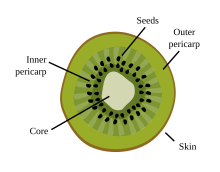
Back Kiwivrug Afrikaans Kiwi AN Cīnisc gōsberige ANG كيوي (فاكهة) Arabic كيوي ARZ Wamin ka kawisitc ATJ Kivi Azerbaijani کیوی AZB Ківі (садавіна) Byelorussian Ківі (садавіна) BE-X-OLD

A = A. arguta, C = A. chinensis, D = A. deliciosa, E = A. eriantha, I = A. indochinensis, P = A. polygama, S = A. setosa.



Kiwifruit (often shortened to kiwi outside Australia and New Zealand), or Chinese gooseberry, is the edible berry of several species of woody vines in the genus Actinidia.[1][2] The most common cultivar group of kiwifruit (Actinidia deliciosa 'Hayward')[3] is oval, about the size of a large hen's egg: 5–8 centimetres (2–3 inches) in length and 4.5–5.5 cm (1+3⁄4–2+1⁄4 in) in diameter. Kiwifruit has a thin, fuzzy, fibrous, tart but edible, light brown skin and light green or golden flesh with rows of tiny, black, edible seeds. The fruit has a soft texture with a sweet and unique flavour.
Kiwifruit is native to central and eastern China.[1] The first recorded description of the kiwifruit dates to the 12th century during the Song dynasty.[4] In the early 20th century, cultivation of kiwifruit spread from China to New Zealand, where the first commercial plantings occurred.[1] The fruit became popular with British and American servicemen stationed in New Zealand during World War II, and later became commonly exported, first to Great Britain and then to California in the 1960s.[1][5]
- ^ a b c d Cite error: The named reference
Mortonwas invoked but never defined (see the help page). - ^ Stirk, Bernadine (2005). "Growing Kiwifruit" (PDF). Pacific Northwest Extension Publishing. Retrieved 4 January 2013.
- ^ Beutel, James A. (1990). "Kiwifruit". In Janick, J.; Simon, J.E. (eds.). Advances in new crops. Timber Press. pp. 309–316. Retrieved 11 September 2018 – via Center for New Crops & Plant Products at Purdue University.
- ^ Ward, Carol; Courtney, David (2013). "Kiwifruit: Taking Its Place in the Global Fruit Bowl". Advances in Food and Nutrition Research. Vol. 68. Elsevier. pp. 1–14. doi:10.1016/b978-0-12-394294-4.00001-8. ISBN 978-0-12-394294-4.
- ^ Green, Emily (8 May 2002). "Kiwi, Act II". Los Angeles Times. Retrieved 4 January 2013.